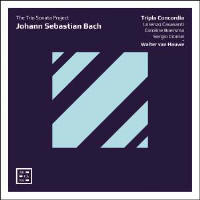Texte paru dans: / Appeared in: |
|
|
Reviewer: James
V. Maiello The concept behind these reworkings of Bach’s trio sonatas is not a novel one, as Walter van Hauwe points out a liner essay on “responsible arranging.” Indeed, composers often adapted their own music and the musical material of others, which was seen as homage rather than as plagiarism. Here, Tripla Concordia have reimagined four trio sonatas and the Partita in D Minor, BWV 997, using recorders as the upper voices. The liner notes also include an inventive transcript of an imaginary interview between Bach and keyboardist Sergio Ciomei, plus Lorenzo Cavasanti’s perceptive comments on the possible origins of these trio sonatas.
The ensemble begins with a declarative reading of the Trio Sonata in C Minor, BWV 1029, originally for viola da gamba and harpsichord. The tempo is brisk, but the recorder passagework is crisp and the continuo is unobtrusive. This arrangement brings out Bach’s debt to Corelli in the second movement. One might wish for a touch less restraint here, but the understated approach sets up a lively finale that is notable for its clarity. Cast as a sonata da chiesa, the Trio Sonata in G Major, BWV 1039 (1027), uses—appropriately—an organ in the continuo, as well as two voice flutes (a recorder that falls somewhere between and alto and tenor instrument). Despite an unfortunate homogeneity in timbre between the solo instruments and the continuo, this is another fine performance, unsentimental and free of excess. This is particularly apparent in the third movement, which maintains a sense of forward motion throughout. A weightless presto concludes the sonata, defined by heroic cello playing and clean—but never clipped—recorder lines.
The Partita in D Minor, BWV 997, is one of the highlights of the program, and one would never guess it was written for solo lute from the expert arrangement for solo recorder and harpsichord. The prelude sounds effortless and fluid, and van Hauwe’s tone is focused and resonant. Sadly, the Fugue has been omitted, but an elegant reading of the Sarabande more than makes up for it. If the Gigue seems on the slow side at first, this is only to ensure that the Double is energetic, but not frantic. The ensemble returns to the church sonata with BWV 1028, scored for two recorders and continuo. The performance is measured and well controlled, though more dramatically shaped lines would not be unwelcome. The final work on the program is an arrangement of the Sonata No. 3 in D Minor for Organ, BWV 527, for soprano, alto, and bass recorders and organ. As in the performance of BWV 1039 (1027), the instrumentation allows the solo instruments to blend into the organ a little too easily, but this is a minor concern. The soprano recorder comes through clearly, but van Hauwe is never too strident or shrill.
Conceptually, this program is encouraging. Baroque music even now still seems to carry some of the philosophical baggage of its 19th-century revival, with emphases on authoritative authorship, urtext editions, and the masterwork. This recording loosens that grip further. It is a reminder of the fluidity and adaptability that was integral to 18th-century music-making in all its contexts. The adaptations and arrangements are consistently tasteful and idiomatic, and the performances are technically impeccable. At times they are a little too objective for my taste, but they are precise, sophisticated, and full of subtle shadings that one appreciates more with each hearing. I look forward to more of this kind of project. | |
|
|
|
|
|
|
|
Cliquez l'un ou l'autre
bouton pour découvrir bien d'autres critiques de CD |
|




